


Malachite

PLACES YOU MIGHT LIKE TO VISIT
IF YOU ARE TRAVELLING AND WOULD LIKE TO SEE A MINERAL COLLECTION, GEMS, FOSSILS etc.
The are many sites in Australia which cater to people interested in gems, minerals, fossils etc. The sites
listed here are sites I have visited over the years and have enjoyed. They provide a pleasant counterpart
to our fossicking activities and deserve to be supported by all lapidary/mineral/fossil enthusiasts.
VIC. N.S.W. QLD TAS. South West Victorian Volcanoes
(NOTE THAT THERE ARE MANY GREAT SITES IN OTHER STATES, BUT I HAVE NOT HAD THE
OPPORTUNITY TO VISIT THOSE SITES YET! SO THIS IS A VERY LIMITED LIST!!!!)


VICTORIA
MELBOURNE MUSEUM: has a great display of ‘Minerals and Gemstones’ as well ‘Fossils & Dinosaurs’ and ‘Meteors and Meteorites’.
Our club has visited the museums ‘mineral vaults’ as well as the public collections and both are worth a look! Club visit to museum link
(photos near bottom of page).
The museum website is at http://museumvictoria.com.au/melbournemuseum/
Portland Gem & Mineral display: this display, located at the ‘Tram Depot’ in Portland in S.W. Victoria is well worth a visit if you are in
the region. For a flavour of the display, take a look at our clubs visit to the display.
The Alan Wood collection: is a private collection located in Mortlake in S.W. Victoria. If is centred around the minerals and gems of Mt
Shadwell, Mortlake. See the Alan Wood Collection page.
N.S.W.
Australian Fossil and Mineral Museum, located in Bathurst, is an excellent museum and well worth a visit if you are in the area. Some
photos of the exhibition are here (photos near bottom of page)! The museum also has a website at with useful information at
URL: http://www.somervillecollection.com.au
LAKE MUNGO N.P.: Located 110km N.E. of Mildura is of geological, biological and cultural significance. As well as having evidence of
at least 40,000 yrs of human habitation is has good examples of erosion features in the lunette known as ‘The walls of china’. Here you
will see distinctly coloured soil layers in the eroded pinnacles and the resultant ‘alluvial fans’.
The walls of china. The lower sediments are
approx. 110,000 y.o., The upper sediments as
recent as 18,000 y.o.
Overlooking the ‘walls of china’ with lake Mungo in
the background (it dried up some 15,000 years
ago). Note the eroded pinnacle in the background
and the characteristic erosion patterns in the
foreground.
Vigars Well, a water hole, with sand dunes in the
background, which are moving east at 3m/year
better indication of the extensive nature of the
sand dunes which form the lunette.
THE ‘ALBERT KERSTEN MINING & MINERALS
MUSEUM’ in Broken Hill has a good display of
local minerals reflecting Broken Hills mining
heritage.
The Silver Tree, an 8 kg silver table centrepiece
owned by Charles Rasp, who held the first mining
lease at Broken Hill.
A 42 kg silver nugget
A small selection of the many specimens at the
museum.
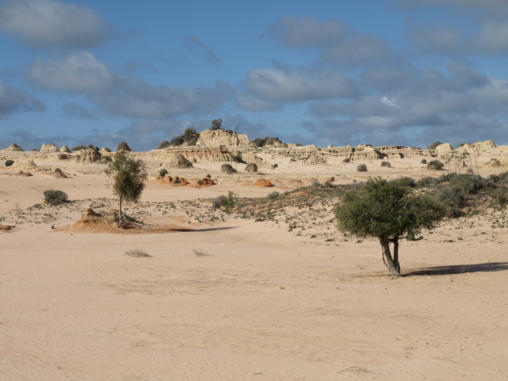
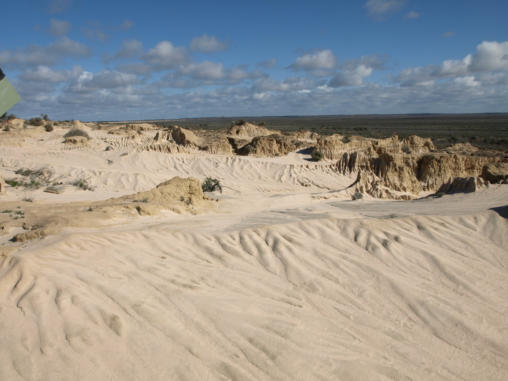
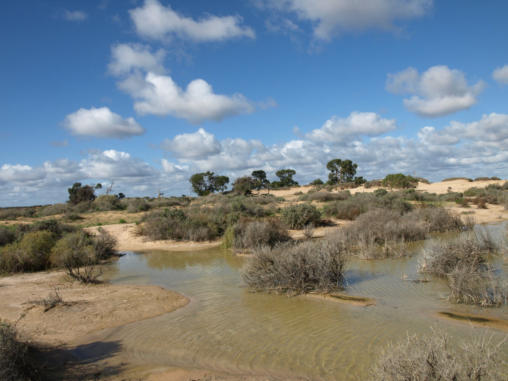
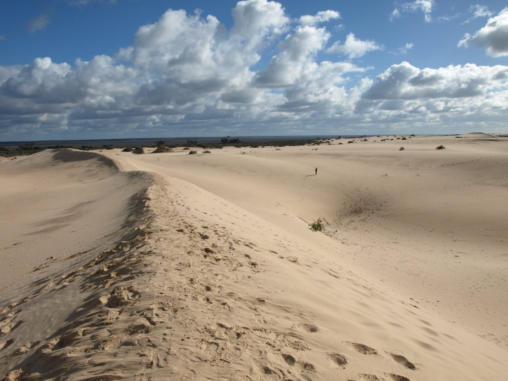
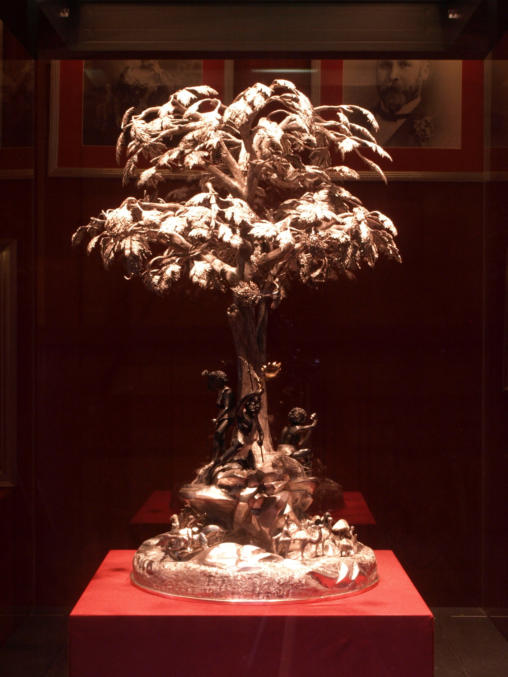
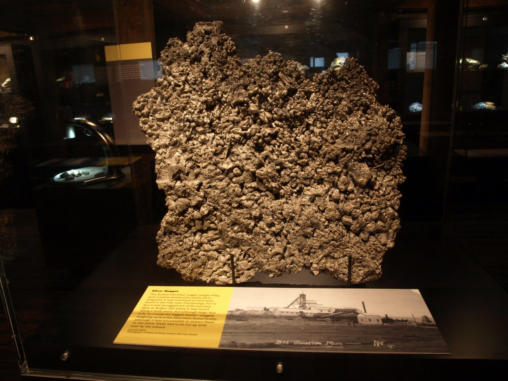
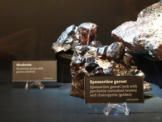
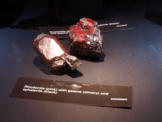
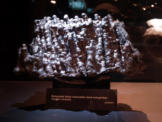
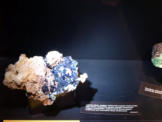
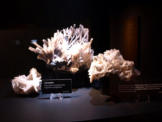
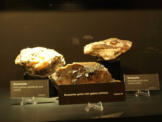
QLD
WINTON: AUSTRALIAN AGE OF DINOSAURS MUSEUM is well worth a visit if you are in western QLD. It is located some 24km from
Winton on a ‘mesa’ with great views of the area. The museum shows where the recovered bones fit in the original dinosaur and you can
see the bones being extracted from the rock in which they were found.
Likely appearance of one of the
dinosaurs which used to roam the
area.
Left: The bones & enclosing rock are
wrapped in a plaster/fabric coating
prior to preparation
Right: Preparation area.
Left: Dinosaur bones partially exposed.
Right: Fossils in different stages of
extraction from the base rock.
A
number of recovered dinosaur bones
(LHS) and a diagram on the RHS
showing where those bones were
located in the dinosaur.
Left: A rather large petrified log.
Right: A dinosaur fossil bone insitu.
Parts of the main display showing the
bones of other dinosaurs.
L
ARK QUARRY: located some 110km
south of Winton preserves some 3300
tracks showing the only recorded
dinosaur stampede on our planet!
View of part of the stampede area.
Some of the stampede dinosaur
footprints.
Other fossils at the site.
Hughenden: at the tourist information
centre you can view a large range of
fossils from QLD.
L: Belemnites can be dug up around
Hughenden.
R: Pliosaur fossils.
Fossilised ammonites and mineral
display’s.
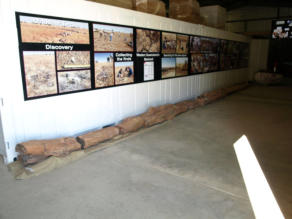
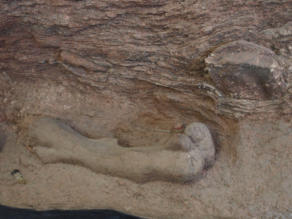
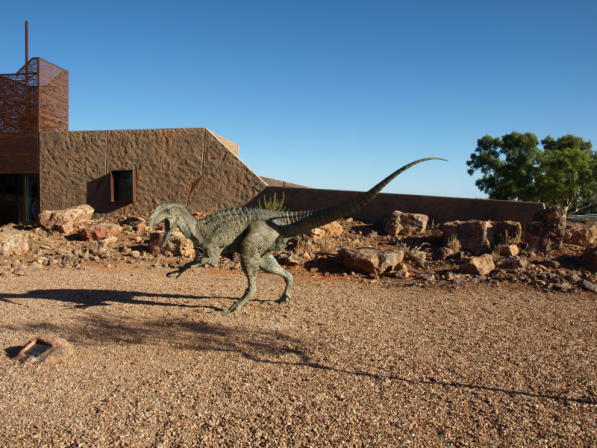
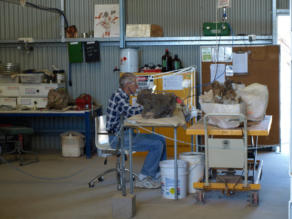
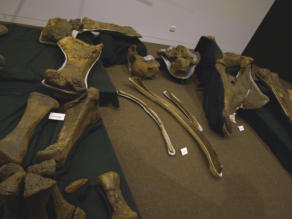
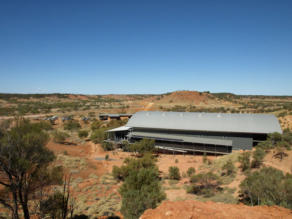
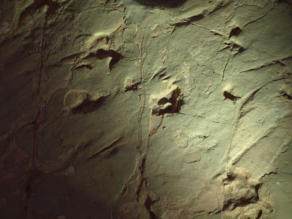
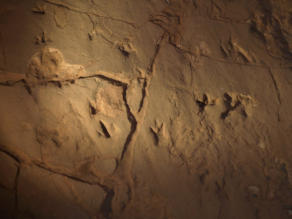
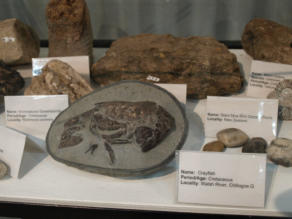
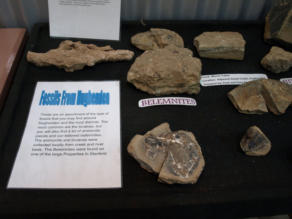
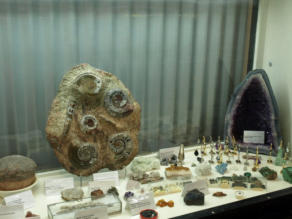
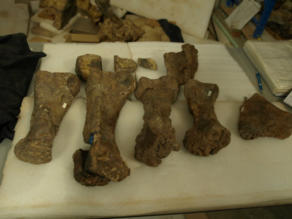
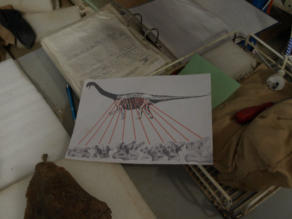
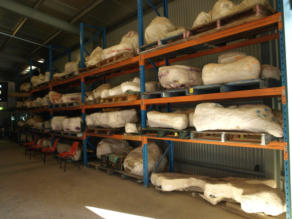
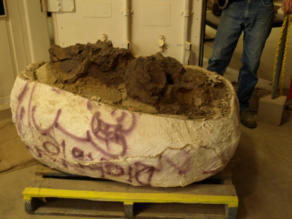
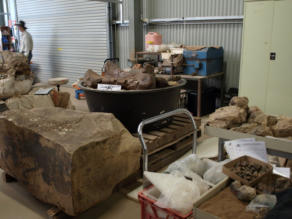
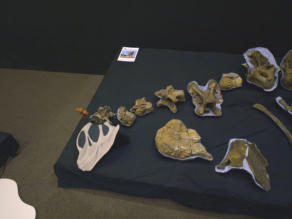
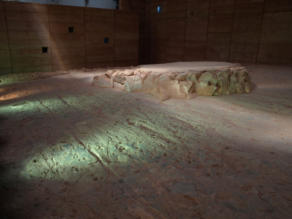
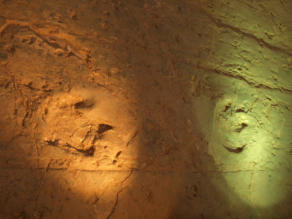
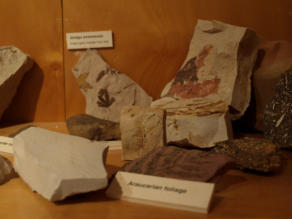
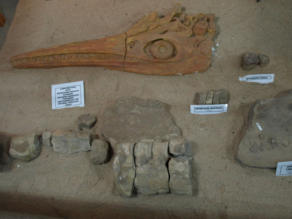
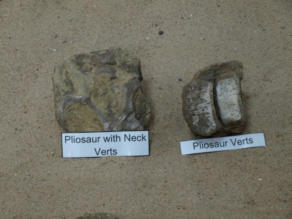
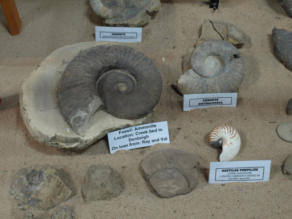
TAS
ZEEHAN The mining musuem is well worth a visit. (No photos on this page due to the policy in place when I
visited, which prohibited any photography.)
HOBART the Tasmanian Museum and Art Gallery in the centre of Hobart (Dunn Pl., between Davey St. and
Macquarie St.) Has a good mineral/gem collection which is worth a visit if you are in the area.
‘ASHWORTHS’ located in Home Hill, south of Townsville,.
Ashworths was founded in 1948 in Ayr by the present owner’s grandfather. It is well worth a visit if you are in the area. They
have a impressive gem/mineral collection in their museum which represents some 60 years of collecting (started by the
grandfather of the current owner). The highlight of the collection for me was the fantastic collection of ‘Agate Creek’ agates.
This is the best collection of agates from Agate Creek that I have been seen, with many different types, varying in size from
approximately 5cm up to 40cm diameter. The range of colours is impressive and some a of the gates do look like ‘pictures’ of
animals or scenery.
The collection also includes a good range of other gem materials collected from around Australia, many of which I wished I
could take home with me.


- index
- contact-us
- club activities 2021 -
- Club activities 2021 --a
- Club activities 2021 --b
- club activities 2019_20
- club activities 2017_18
- club activities 2016
- club activities 2015_2014
- club activities 2013_2012_2011
- club activities 2010_2009_2008
- club activities 2007_2006_2005_2004
- club shows 2004_2016
- club shows 2018 _
- office bearers and life members
- club history
- links
- fossicking in south west victoria
- places you might like to visit
- europe 2014
- usa_canada_gems_geology
- Canada_hawaii_gems_geology
- gem_mineral collections
- some australian gems
- Gem articles
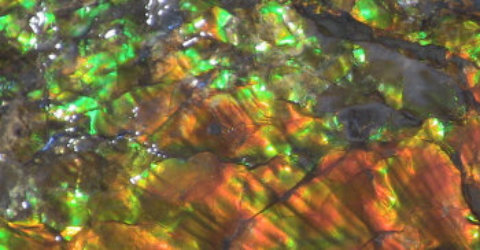


Elbaite crystals

PLACES YOU MIGHT LIKE TO VISIT
IF YOU ARE TRAVELLING AND WOULD LIKE TO SEE A MINERAL
COLLECTION, GEMS, FOSSILS etc.
The are many sites in Australia which cater to people interested in gems,
minerals, fossils etc. The sites listed here are sites I have visited over the
years and have enjoyed. They provide a pleasant counterpart to our
fossicking activities and deserve to be supported by all
lapidary/mineral/fossil enthusiasts.
VIC. N.S.W. QLD TAS. South West Victorian Volcanoes
(NOTE THAT THERE ARE MANY GREAT SITES IN OTHER STATES,
BUT I HAVE NOT HAD THE OPPORTUNITY TO VISIT THOSE SITES
YET! SO THIS IS A LIMITED LIST!!!!)

VICTORIA
MELBOURNE MUSEUM: has a great display of ‘Minerals and
Gemstones’ as well ‘Fossils & Dinosaurs’ and ‘Meteors and Meteorites’.
Our club has visited the museums ‘mineral vaults’ as well as the public
collections and both are worth a look! The museum website is at
http://museumvictoria.com.au/melbournemuseum/
Portland Gem & Mineral display: this display, at the ‘Tram Depot’ in
Portland in S.W. Victoria is worth a visit if you are in the region. For a
flavour of the display, take a look at our clubs visit to the display.
The Alan Wood collection: is a private collection located in Mortlake in
S.W. Victoria. If is centred around the minerals and gems of Mt Shadwell,
Mortlake. See the Alan Wood Collection page.
N.S.W.
Australian Fossil and Mineral Museum, located in Bathurst, is an
excellent museum and well worth a visit if you are in the area. Some
photos of the exhibition are here (photos near bottom of page)! The
museum also has a website at with useful information at
URL: http://www.somervillecollection.com.au
LAKE MUNGO N.P.: Located 110km N.E. of Mildura is of geological,
biological and cultural significance. As well as having evidence of at least
40,000 yrs of human habitation is has good examples of erosion features
in the lunette known as ‘The walls of china’. Here you see distinctly
coloured soil layers in the eroded pinnacles and the resultant ‘alluvial
fans’.
The walls of china. The
lower sediments are
approx. 110,000 y.o., The
upper sediments as recent
as 18,000 y.o.
Overlooking the ‘walls of
china’ with lake Mungo in
the background (it dried up
some 15,000 years ago).
Note the eroded pinnacle in
the background and the
characteristic erosion
patterns in the foreground.
Vigars Well, a water hole,
with sand dunes in the
background, which are
moving east at 3m/year
A better indication of the
extensive nature of the
sand dunes which form the
lunette.
THE ‘ALBERT KERSTEN
MINING & MINERALS
MUSEUM’ in Broken Hill
has a good display of local
minerals reflecting Broken
Hills mining heritage.
The Silver Tree, an 8 kg
silver table centrepiece
owned by Charles Rasp,
who held the first mining
lease at Broken Hill.
A 42 kg silver nugget
A small selection of the
many specimens at the
museum.
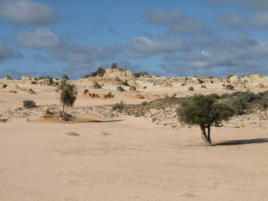
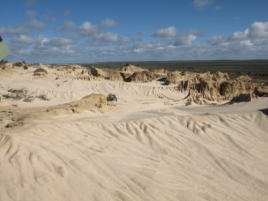
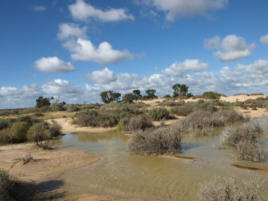
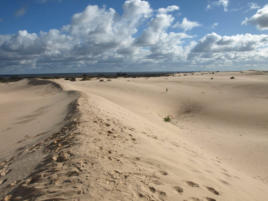
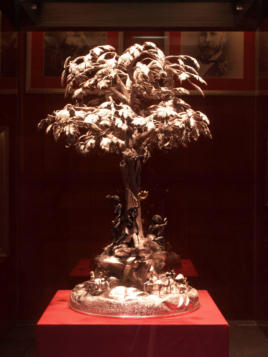
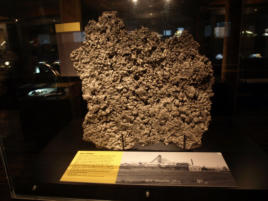






QLD
WINTON: AUSTRALIAN AGE OF DINOSAURS MUSEUM is well
worth a visit if you are in western QLD. It is located some 24km from
Winton on a ‘mesa’ with great views of the area. The museum shows
where the recovered bones fit in the original dinosaur and you can see
the bones being extracted from the rock in which they were found.
Likely appearance of one of the
dinosaurs which used to roam the
area.
The bones & enclosing rock are
wrapped in a plaster/fabric
coating prior to preparation
A diagram howing where those
bones were located in the
dinosaur.
Left: A rather large petrified log.
Parts of the main display showing
the bones of another dinosaur.
LARK QUARRY: located some
110km south of Winton preserves
some 3300 tracks showing the
only recorded dinosaur stampede
on our planet!
View of part of the stampede
area.
Some of the stampede dinosaur
footprints.
Other fossils at the site.
Hughenden: at the tourist
information centre you can view a
large range of fossils from QLD.
Fossilised ammonites .
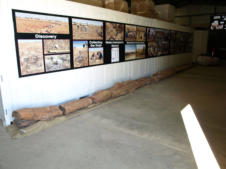
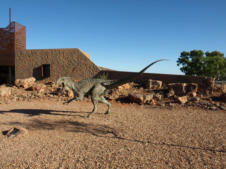
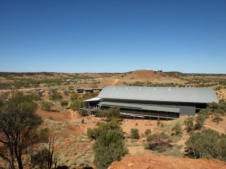
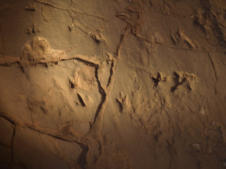
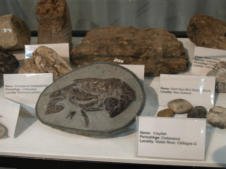
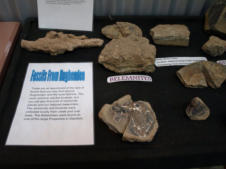
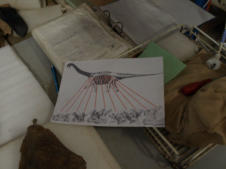
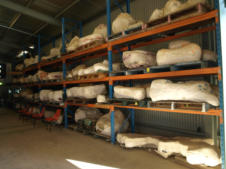
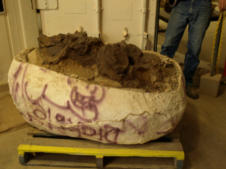
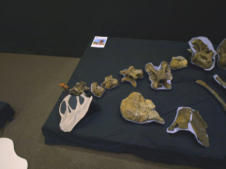
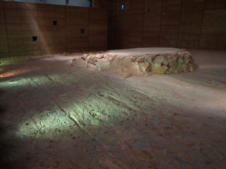
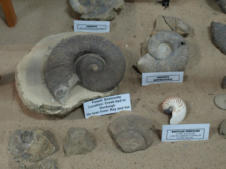
TAS
ZEEHAN The mining musuem is well worth a visit. (No photos on this
page due to the policy in place when I visited, which prohibited any
photography.)
HOBART the Tasmanian Museum and Art Gallery in the centre of
Hobart (Dunn Pl., between Davey St. and Macquarie St.) Has a good
mineral/gem collection which is worth a visit if you are in the area.
‘ASHWORTHS’ located in Home
Hill, south of Townsville,.
Ashworths was founded in 1948 in Ayr by the present owner’s
grandfather. It is well worth a visit if you are in the area. They have a
impressive gem/mineral collection in their museum which represents
some 60 years of collecting (started by the grandfather of the current
owner). The highlight of the collection for me was the fantastic
collection of ‘Agate Creek’ agates. This is the best collection of agates
from Agate Creek that I have been seen, with many different types,
varying in size from approximately 5cm up to 40cm diameter. The range
of colours is impressive and some a of the gates do look like ‘pictures’
of animals or scenery.
The collection also includes a good range of other gem materials
collected from around Australia, many of which I wished I could take
home with me.


- index
- contact-us
- club activities 2021 -
- Club activities 2021 --a
- Club activities 2021 --b
- club activities 2019_20
- club activities 2017_18
- club activities 2016
- club activities 2015_2014
- club activities 2013_2012_2011
- club activities 2010_2009_2008
- club activities 2007_2006_2005_2004
- club shows 2004_2016
- club shows 2018 _
- office bearers and life members
- club history
- links
- fossicking in south west victoria
- places you might like to visit
- europe 2014
- usa_canada_gems_geology
- Canada_hawaii_gems_geology
- gem_mineral collections
- some australian gems
- Gem articles











